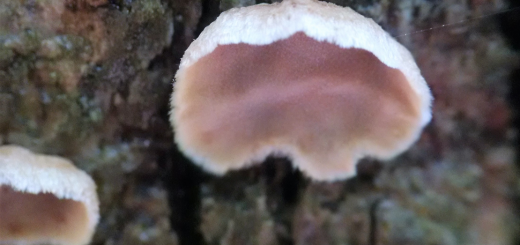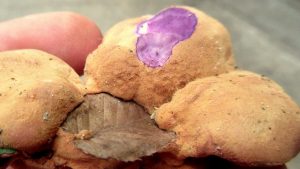#040: Mushroom Morphology: Stinkhorns
As the name suggests, this group is made up of the most pungent fungi. The defining characteristic of this group is that they all produce a dark, smelly slime that carries their spores. This slime smells like rotting flesh for the express purpose of attracting flies and beetles. The insects walk around in the spore slime and then fly away, carrying some of the mushroom’s spores on their legs. After visiting a stinkhorn, the insects either land on real rotting material or on another stinkhorn. In the first case, the rotting material serves as a substrate on which the spores can grow. When the insect lands on another stinkhorn, this allows for cross-fertilization (much like insect pollination of flowers). The other factor that all stinkhorns have in common is that they have a button stage. All stinkhorns form a small, white, oval-shaped structure, or “egg” that contains the basic form of the mature mushroom before they actually fruit. Because the mushroom is mostly formed before it fruits, stinkhorns can appear rapidly when in moist conditions. In fact, if you find some stinkhorn “eggs” you can get them to fruit indoors by simply placing it in a most chamber, like a bell jar. Just be prepared to deal with the smell of rotting flesh indoors!
Stinkhorns exhibit a variety of shapes, so I will go through a few examples. The simplest stinkhorns look something like an elongated cone with the top portion covered in spore slime. This is the first of many stinkhorns that are phallic-shaped. Mutinus caninus has a long, white stalk that is covered on the top by black spore slime. This mushroom’s resemblance to a certain part of a dog’s anatomy resulted in its scientific name. More complicated stinkhorns have a small head at the top of the stalk instead of bearing the spore slime directly on the stalk. The mushroom Phallus rubicundus looks much like an orange version of M. caninus, except that the spore slime is not borne directly on the stalk. Other variations on this morphology include adding wrinkles to the head (in a sort of morel-like fasion) and adding a doily-like “skirt” to the edge of the cap, as in Phallus duplicatus. Other stinkhorns look like Wiffle balls or soccer ball outlies (as in Clathrus crispus), sometimes placed at the end of a stalk (as in Lysurus periphragmoides). Simpler stinkhorns consist of a few columns that fuse at the top, as in Clathrus columnatus. In stinkhorns such as these, which have holes running through the center, the spore slime is usually borne on the interior of the mushroom. Other stinkhorns, like Aseröe rubra, have arms radiating from a central stalk, making it look like an octopus. There are a number of other stinkhorn shapes, such as a lantern or a napkin in a ring.
A quick internet search for “stinkhorn” turns up a lot of results that offer ways to get rid of stinkhorns. Apparently most people find these beautiful mushrooms a nuisance when they unexpectedly fruit in one’s yard. Fortunately, there is no way to get rid of stinkhorns (not that you would want to in the first place). These mushrooms are saprophytes, so they are usually found decomposing mulch. This releases nutrients and helps create soil, which is beneficial to your garden. Because stinkhorn mushrooms are mostly water they dry out very quickly and are rarely a nuisance for very long. My advice for dealing with stinkhorns is to appreciate their beauty. Alternatively, you could try eating the offending mushrooms. Believe it or not, stinkhorns are edible! Apparently they are considered a delicacy in China and are cultivated and sold in stores. You can eat them either in their gelatinous, egg stage or once you remove the spore slime from a mature mushroom. However, be warned: Amanita buttons can look a lot like stinkhorn eggs. The difference is that Amanitas can be deadly poisonous (see FFF#050 for example). Before you eat a stinkhorn egg, cut it open to make sure that there is a mass of dark-colored spores inside. If you don’t see any dark-colored spores, do not eat it!
All stinkhorns are found in the phylum Basidiomycota, class Agaricomycetes, order Phallales. All fungi in this order produce a stinky spore mass, making the stinkhorns a monophyletic group. These fungi are part of the Gasteromycetes, which is a group of fungi that expose their spores after they are mature. All of the other basidiomycete mushrooms that I have discussed so far are Hymenomycetes and expose the spore-bearing surface before all the spores have matured. The gasteromycetes have all lost the ability to form ballistospores (see FFF#013 for more on ballistospores). This means that none of these fungi can launch individual spores into the air. Therefore, they have to rely on other mechanisms to disperse their spores. Stinkhorns deal with this by relying on insects to carry their spores, as discussed earlier. These truly are some of the most interesting and beautiful mushrooms in the world.
This post does not contain enough information to accurately identify any mushroom. Never eat any mushroom without using a field guide to identify it. If you need a free, quality field guide, I recommend Michael Kuo’s MushroomExpert.com.
See Further:
http://www.mushroomexpert.com/phallaceae.html








![#011: Characteristics of Kingdom Fungi [Archived]](https://www.fungusfactfriday.com/wp-content/themes/hueman/assets/front/img/thumb-small-empty.png)


2 Responses
[…] Of course, the most fascinating part of the stinkhorn story is their relationship with insects. Bugs, especially flies, are attracted by the foul smells, walk around in the spores, and then carry the spores to new locations. To read more about the stinkhorn life cycle, see FFF#040.7 […]
[…] the Dog’s Nose Fungus uses a strategy similar to stinkhorns (FFF#040) and Cedar-Apple Rust pycnia (FFF#087): the slime attracts certain insects, the insects walk around […]